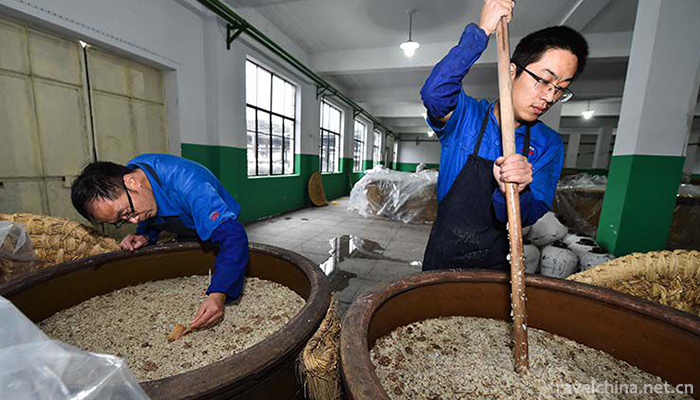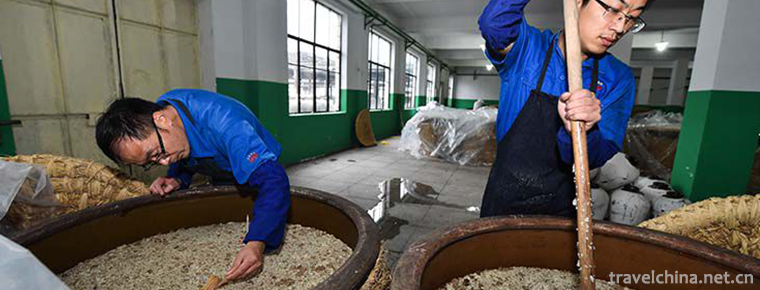Brewing Techniques of Shaoxing Yellow Rice Wine
Brewing Techniques of Shaoxing Yellow Rice Wine
Shaoxing rice wine brewing technology, Shaoxing local traditional handicraft, Zhejiang Province, one of the national intangible cultural heritage.
Shaoxing has a long history of brewing wine, which can be traced back to the Spring and Autumn Period and the Warring States Period. By the time of the Northern and Southern Dynasties, it was well-known. Yellow rice wine had been listed as a tribute. "Draw water from the lake in Menqianjian, and brew Shaojiu Wanli fragrance."
On May 20, 2006, Shaoxing rice wine brewing technology was approved by the State Council and listed in the first batch of national intangible cultural heritage list, project number_-60.
historical origin
From the records of the Spring and Autumn Period of Lushi, Shaoxing liquor has appeared frequently in historical documents. Especially the famous food work Tiaoding Ji in Qing Dynasty comprehensively expounded the historical evolution, variety and fine quality of Shaoxing liquor. At that time, Shaoxing liquor was popular all over the country and had a unique style among liquors. Shaoxing liquor is famous at home and abroad mainly because of its excellent quality. Yuan Mei of the Qing Dynasty praised "Shaoxing liquor is like a clean and honest official, without any falsehood, and its flavor is really like a famous scholar Qiying, staying in the world for a long time, and the more sophisticated it is, the thicker it is." In Tiaoding Ji, Shaoxing liquor is compared with other local liquors: "Like world liquor, there are many gray people who drink it thirsty, but Shaoxing liquor is unique; most of the world's liquors are sweet, and the human body is full of depression, while the nature of Shaoxing liquor is fragrant and mellow, but they do not keep it, so the addicts are the top quality, not private comment." The quality of Shaoxing liquor was summarized as "sweet taste, clear color, fragrance and alcohol are the top quality, while Chen Shaoxing liquor is the first one". This shows that Shaoxing liquor has dominated in the four aspects of color, aroma and taste.
Because of the difference of location and operation skills of breweries, Shaoxing liquor is divided into two schools: the Eastern Band and the Western Band. Breweries located in Xidongpu, Ruan She and Hutang of Shaoxing City are called "the Western Band". Breweries in Doumen, Mashan, Sun Duan, Gaobu, Taoyan and Dongguan are called "the Eastern Band".
Technological characteristics
Shaoxing rice wine is rich in nutrients. According to scientific determination, it contains 21 kinds of amino acids, including eight essential amino acids which can not be synthesized by human body. Shaoxing rice wine is full of fragrance and good in color, aroma and taste.
1. Color
Shaoxing rice wine is mainly amber, that is, orange, transparent and clear, pure and lovely, pleasing to the eye. This transparent amber color mainly comes from the natural pigments of raw rice and wheat itself and the addition of appropriate sugar color.
2. Fragrance
Shaoxing rice wine has an attractive fragrance. All famous wines are heavy fragrance. The unique fragrance of Shaoxing liquor is not a special heavy fragrance, but a complex fragrance composed of esters, alcohols, aldehydes, acids, carbonyl compounds and phenols. These aromatic substances come from the metabolism of rice, wheat starter itself and various microorganisms during fermentation and the reaction between alcohol and acid during storage. They combine to produce steamed fragrance, and tend to become stronger over time. So Shaoxing liquor is called old liquor, because the older it is, the more fragrant it is.
3. Taste
Shaoxing rice wine is a harmonious blend of six flavors, namely:
Sweetness: There are 89 kinds of sugars produced by enzymatic hydrolysis of rice and wheat koji, mainly including glucose and maltose. In addition, 2,3-butanediol, glycerol, dextrin and polyols were produced during fermentation. These substances are sweet, thus giving Shaoxing liquor moist, full, strong endoplasm, when drinking with a sweet and sticky feeling.
Acidity: Acidity can increase strong taste and reduce sweetness. There are more than 10 organic acids in Shaoxing liquor, such as acetic acid, lactic acid and succinic acid. It mainly comes from rice, koji and the addition of pulp water and aldehyde oxidation, but most of it is produced by yeast metabolism during fermentation. Among them, acetic acid, butyric acid and other volatile acids are the main substances leading to alcoholic sensation; succinic acid, lactic acid, tartaric acid and other volatile acids are the main substances leading to aftertaste. Insufficient acidity, often dull; excessive acidity, and rough octanoic acid; only a certain amount of a variety of acids, can constitute a sweet, refreshing, mellow and unique flavor. The so-called "old" and "tender" of wine refers to the content of acid, which plays a vital role in buffering the taste of wine.
Bitter taste: Bitter substances in wine are highly sensitive in taste and last for a long time, but they are not necessarily bad taste. The bitterness of Shaoxing rice wine mainly comes from some amino acids, tyrosols, methionine adenosine and amines produced during fermentation. In addition, sugar can also bring some bitterness. Proper bitterness refreshes the taste and brings a special flavor to the wine.
Spicy (spicy): Spicy is not the taste pursued by drinkers, but it is an indispensable taste in Shaoxing rice wine. It is composed of alcohol, higher alcohols and acetaldehyde, mainly alcohol. Moderate spicy taste can promote appetite. Without moderate spicy taste, it will lack a sense of taste just like drinking ordinary drinks.
Taste: The flavor of Shaoxing rice wine comes from glutamic acid, aspartic acid, lysine, aspartic acid, lysine and other amino acids, as well as polypeptide and nitrogen base produced by protein hydrolysis. These substances all have a delicious taste. In addition, substances such as 5-nucleic acid produced by succinic acid and yeast autolysis also have a delicious taste. The flavor of Shaoxing yellow rice wine is unique and popular with drinkers. The flavor of Shaoxing yellow rice wine is more obvious than other yellow rice wine.
Astringent taste: The astringent and bitter taste of Shaoxing rice wine are produced at the same time. The astringent taste is mainly composed of lactic acid, tyrosine, isobutanol and isoamyl alcohol. Suitable bitterness and astringency will not make the wine show distinct bitterness and astringency, on the contrary, it will make the wine have a strong soft taste.
The above six flavors of Shaoxing rice wine have mutual restriction and influence on each other. Harmoniously merging together, the Shaoxing rice wine has formed its unusual color, aroma and taste. Shaoxing yellow wine is clear, mellow, sweet and fragrant. Its color, fragrance and aroma are amazing.
Inheritance and Protection
Inheritance value
In the process of wine-making and the evolution of wine culture in Shaoxing, there are many folk activities. Through labor, the process of wine-making has evolved into a style, and then precipitated into a culture. Shaoxing is the birthplace of rice wine culture. Rice wine is rooted in life. It has a vigorous vitality and is a typical intangible cultural heritage. But this intangible cultural heritage needs human "memory" and a carrier and platform to inherit. Yellow rice wine is not only a kind of material, but also a kind of culture, which is the soul of the water village, closely linked with local folklore and customs, and also a kind of cohesion of beauty.
Current situation of inheritance
In recent years, due to the long brewing cycle, high requirement of brewing water and other raw materials, complex technology and experience, it is difficult to expand the reproduction of Shaoxing rice wine. Under the impact of the commercial tide, the traditional brewing techniques of Shaoxing liquor are in an endangered situation.
Heritage figures
Wang A Niu, male, born in September 1925. In June 2007, Wang A Niu was selected as the representative successor of the first batch of national intangible cultural heritage projects, inheritance project: Shaoxing rice wine brewing technology.
protective measures
In July 2016, at the demonstration meeting of China Wine Industry Association held in Keqiao, Shaoxing, the old factory area of Jianhu Wine Brewing Co., Ltd. was successfully applied for the protection base of Shaoxing Yellow Wine Traditional Brewing Industrial Heritage, relying on the advantages of "original address, original factory building, original technology and original brand".
social influence
Honorary recognition
In 1915, Zhou Qing, the fifth generation descendant of Yunji Wine Works (the predecessor of Shaoxing Huiji Shan Shaoxing Wine Co., Ltd.), sent a pot of centuries old wine brewed by his ancestors and four pots of "Yunji Old Wine" brewed by himself to Panama Pacific World Expo. In the end, the gathered wine won the recognition of the world's first-class wine judges for its excellent quality, and won the first international gold medal for Shaoxing rice wine.


-
1.Tangwang River Linhai Qishi Scenic Area
Tangwanghe Linhai Qishi Scenic Area is located in Tangwanghe District, Yichun City, Heilongjiang Province.
Time 2018-12-05 -
2.Taining Scenic Tourist Area
Taining Scenic Spot: World Geopark, National AAAAA Class Tourist Spot, National Key Scenic Spot, National Forest Park, National Geopark, National Key Cultural Relics Protection Unit
Time 2018-12-08 -
3.south china botanical garden
The South China Botanical Garden of the Chinese Academy of Sciences, which belongs to the Chinese Academy of Sciences, is one of the most important botanical and ecological research institutions in Ch
Time 2018-12-26 -
4.Nangongshan National Forest Park
Nangongshan National Forest Park, located in Langao County, Ankang City, Shaanxi Province, is a branch of Hualongshan Mountain of Daba Mountain System, 33 kilometers from the county seat
Time 2018-12-27 -
5.Huangshan Yi Culture Tourist Area
Huangshan Yi Cultural Park is a national AAAA-level tourist attraction, located in the northwest of Linyi Economic and Technological Development Zone.
Time 2019-01-18 -
6.Bouyei Leyou
Le You and Le Lang are Buyi oboe gas song instruments. They resemble suona, bowl-less, insect whistle playing, bright and sweet timbre. It can be used for Solo or singing accompaniment
Time 2019-04-04 -
7.dongjing music
Dongjing music is a very ancient traditional instrumental music, which originated in Sichuan Province in the Song Dynasty and is now popular in Sichuan Province
Time 2019-04-28 -
8.Huizhou three carving
The three carvings in Huizhou are a kind of local traditional carving art. They refer to three kinds of local traditional carving crafts, i.e. wood carving, stone carving and brick carving,
Time 2019-05-04 -
9.Making Techniques of Lanzhou Yellow River Waterwheel
Lanzhou Yellow River waterwheel production technology, Lanzhou City, Gansu Province, local traditional handicraft, one of the national intangible cultural heritage.
Time 2019-05-10 -
10.Firing Techniques of Ru Porcelain
On May 23, 2011, the firing technique of Ru Porcelain was approved by the State Council of the People's Republic of China and listed in the third batch of national intangible cultural heritage, the he
Time 2019-06-11 -
11.Xiling Snow Mountain
Xiling Snow Mountain, located in Dayi County, Chengdu City, Sichuan Province, is only 95 kilometers away from Chengdu, with a total area of 483 square kilometers. It is a world natural heritage, giant panda habitat, AAAA tourist attraction and national key scenic spot.
Time 2020-11-06 -
12.Location of Yibin
Yibin City is located in the south of Sichuan Province, at the junction of Sichuan, Yunnan and Guizhou provinces, and the confluence zone of Jinsha River, Minjiang River and Yangtze River. It spans 27 ° 50 '- 29 ° 16' n and 103 ° 36 '- 105 ° 20' E. The cit
Time 2020-12-18